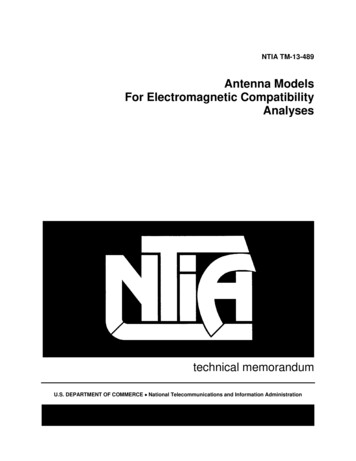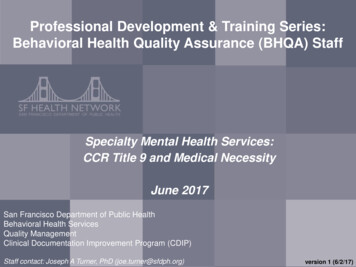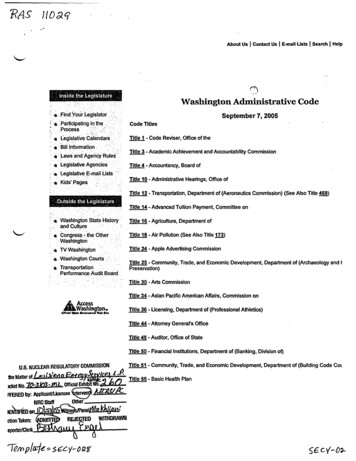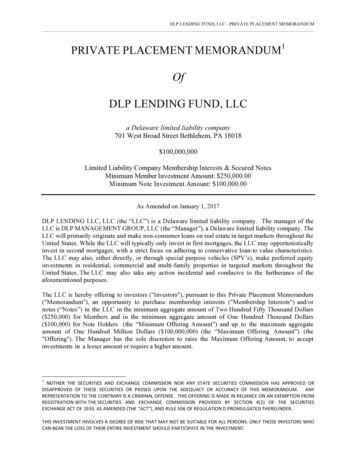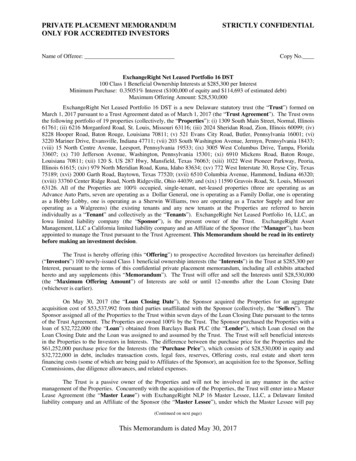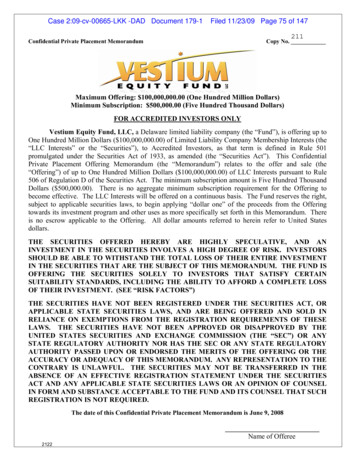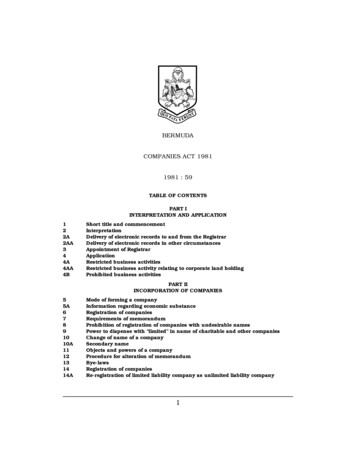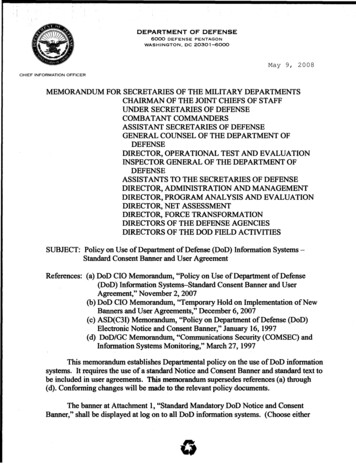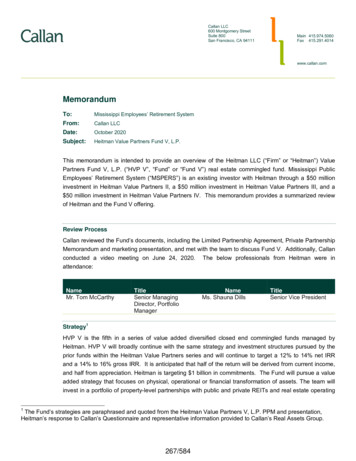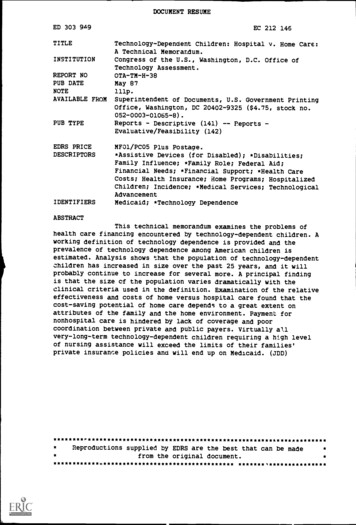
Transcription
DOCUMENT RESUMEED 303 949TITLEINSTITUTIONREPORT NOPUB DATENOTEAVAILABLE FROMPUB TYPEEDRS PRICEDESCRIPTORSIDENTIFIERSEC 212 146Technology-Dependent Children: Hospital v. Home Care:A Technical Memorandum.Congress of the U.S., Washington, D.C. Office ofTechnology Assessment.OTA-TM-H-38May 87111p.Superintendent of Documents, U.S. Government PrintingOffice, Washington, DC 20402-9325 ( 4.75, stock no.052-0003-01065-8).Reports - Descriptive (141) -- reports Evaluative /Feasibility (142)MF01/PC05 Plus Postage.*Assistive Devices (for Disabled); *Disabilities;Family Influence; *Family Role; Federal Aid;Financial Needs; *Financial Support; *Health CareCosts; Health Insurance; Home Programs; HospitalizedChildren; Incidence; *Medical Services; TechnologicalAdvancementMedicaid; *Technology DependenceABSTRACTThis technical memorandum examines the problems ofhealth care financing encountered by technology-dependent children. Aworking definition of technology dependence is provided and theprevalence of technology dependence among American children isestimated. Analysis shows that the population of technology-dependentchildren has increased in size over the past 25 years, and it willprobably continue to increase for several more. A principal findingis that the size of the population varies dramatically with theclinical criteria used in the definition. Examination of the relativeeffectiveness and costs of home versus hospital care found that thecost-saving potential of home care depends to a great extent onattributes of the family and the home environment. Payment fornonhospital care is hindered by lack of coverage and poorcoordination between private and public payers. Virtually allvery-long-term technology-dependent children requiring a high levelof nursing assistance will exceed the limits of their families'private insurance policies and will end up on Medicaid. (JDD)**Reproductions supplied by EDRS are the best that can be madefrom the original document.
U.S DEPARTMENT OF EDUCATIONOffice of Educational Research and improvamantEDUCATIONAL RESOURCES INFORMATIONCENTER (ERIC)This document I , been reproduced asreceived from the person or organizationoriginating itMinor changes have been made to improvereproduction qualityPoint, of view or opinions stated in this dor Lhmen, do not necessarily represent officialOERI position or policy
SenateHouseofO'C\ G HAT( ric,EOLIGE E BROWN, IRCa/ tomfahiIOHN D DINGELLAhchigan\I KE\\tCI APENCE E MILLEROhiofa,sac Lza.ttt,F1011DON SUNDQUISTSouth (arolma7 ennesseeAMO Hai( 'TONCLAIBORNE PELLRhoceNets YorkJOHN 1-1 GIBBONS(NonvotIng)Advisory CouncilI, Chairman1[02 let imol,wv ."artnerc\5iIf ER Via Char manC. rr: rciI,RetlaLr:CLAIRT T DEDRICKCalztorma Land CommissionRACHEL McCULLOCHUniversity ol WisconsinS DAVID FREEMANI owcr Colorado River AathorittCHASE N 'ETERSONUniversity of UtahNIICHEI1BO!] TYT Haibmity Fneitv,' Co.;L'd,fOIL. 0JDSEPFI E ROSSConwcs,ionai Research ServiceCARL N. HMI ESLEWIS FIOMASUmieisity vt Arizo.ri,iAieniona,"-;7,wn-KetteringCancer CenterDirector
TECHNOLOGY-DEPENDENTCHILDREN: HOSPITAL v.HOME CAREA TECHNICAL MEMORANDUMMAY 1987CONGRESS OF THE UNITED STATES'Office of Technology A sssss men,v.cocc OC 2051 0 80251A
Recommended Citation:U.S. Congress, Office of Technology Assessment, Technology-Dependent Children: Hospi-tal v. Home CareA Technical Memorandum, OTA-TM-H-38 (Washington, DC: U.S.Government Printing Office, May 1987).Library of Congress Catalog Card Number 87-619805For sale by the Superintendent of DocumentsU.S. Government Printing Office, Washington, DC 20402-9325(order form on p. 107)J
ForewordThis technical memorandum is about problems arising out of success. Recent advances in medical technology have permitted sick children who once would have liedto survive with the assistance of sophisticated equipment and intensive nursing care.Often, the sistance is needed for just a short time, but sometimes the dependence onlife-sustaining technology is permanent. As technology for helping keep children alivehas improved, a new population of technology-dependent children has emerged.This small but growing population of children raises new problems for the healthcare system. Because the care is expensiveoften more expensive than most Americanfamilies can affordchildren and their families depend on third-party payersinsurancecompanies, Medicaid, or philanthropiststo finance the needed care. But the structureof the health insurance system has not kept pace -.'411 the needs of these children. .technology-dependent children are eligible for Medicaid coverage in the hospital, t utcoverage of home care is more 1.imited. Consequently, some children have remainodhospitalized even when their families are able to provide good, lower cost care in thehome.OTA was requested by the House Energy and Commerce Committee and the Senate Labor and Human Resources Committee to examine the problems of health carefinancing encountered by technology-dependent children as part of a larger assessment,Technology and Children's Health. The committees wanted to know how many children are technology dependent, how home care and hospital care compare in cost, andhow well private and public third-party payers cover the services needed by these children.This technical memorandum provides a working definition of technology dependence and estimates the prevalence of technology dependence among American children. A principal finding is that the size of the population varies dramatically with theclinical criteria used in the definition. OTA has also found that the cost-saving potential of home care depends to a great extent on attributes of the family and the homeenvironment. The ability and willingness of family members to provide ongoing nursing care for a substantial part of the day are central to lowering costs to third-partypayers, although they may require great sacrifice on the part of the family.The conduct of this study was guided by the advisory panel for the OTA assessment Technology and Children's Health, chaired by Harvey Fineberg. In addition, manygovernment officials and health care professionals were consulted. Information and insights provided by parents of technology-dependent children were also very helpful.Key OTA staff involved in the analysis and writing of the technical memorandum wereElaine J. Power and Judith L. Wagner.741al4u-d-, .(T444JOHN H. GIBBONSDirector6ttt
Advisory Panel on Technology and Children's HealthHarvey Fineberg, ChairmanHarvard School of Public Health, Boston, MALu Ann AdayPhyllis LeppertCenter for Hospital Administration StudiesPerinatal ResearchUniversity of ChicagoSt. Lukes/Roosevelt Hospital CenterChicago, ILColumbia UniversityNew York, NYJulianne BeckettChild Health Specialty ClinicHarvey LevyUniversity of IowaIEM-PKU Program, Childreiis' HospitalIowa City, IABoston, MADonald BerwickEdward LisQuality of Care MeasurementsDivision of Services for Crippled ChildrenHarvard Community Health PlanUniversity of IllinoisBoston, MAChicago, ILAlexander CapronJoanne MaconMedicine and Public PolicyHolman Health RegionUniversity of Southern CaliforniaChicago Department of HealthLos Angeles, CAChicago, ILNorman FostProgram on Medical EthicsDepartment of PediatricsUniversity of Wisconsin HospitalMadison, WIRobert GoldenbergDepartment of Obstetrics and GynecologyUniversity of AlabamaBirmington, ALMichael GrossmanHealth Econamics ResearchNational Bureau of Economic ResearchNew York, NYRobert HaggertyW.T. Grant FoundationNew York, NYJohn Mac QueenChild Health Specialty ClinicUniversity of IowaIowa City, IAJanet ReisSchool of Nursing/SUNY BuffaloBuffalo, NYSarah RosenbaumChildren's Defense FundWashington, DCBarbara StarfieldDivision of Health PolicyJohns Hopkins UniversitySchool of Hygiene and Public HealthBaltimore, MDPatricia KingGeorgetown Law CenterWashington, DCNOTE: OTA appreciates and is grateful for the valuable assistance and thoughtful critiques provided by the advisory panelmembers. The panel does not, however, necessarily approve, disapprove, or endorse this technical memorandum.OTA assumes full responsibility for the technical report and the accuracy of its contents.Iv7
OTA Project StaffTechnology-Dependent Children Hospital v. Home CareRoger C. Herdman, Assistant Director, OTA,Health and Life Sciences DivisionClyde J. Behney, Health Program ManagerJudith L. Wagner, Project DirectorElaine J. Power, Study DirectorOther Contributing StaffDavid Alberts, Research AssistantPolly Ehrenhaft, Senior AnalystMarvin Feuerberg, AnalystMary Anr Hughes, Research AnalystVirginia Cwalina, Administrative AssistantCarol Ann Guntow, P.C. SpecialistKaren T. Davis, Secretary/Word Processor SpecialistContractorHarriette Fox, Fox Consultants, Inc.,Washington, DCSv
ContentsPage3333Chapter 1: SummaryIntroduction .Summary of FindingsThe Population .Relative Effectiveness and Costs ofHome v. Hospital Care . .Sources of Financing for Home.Medical CareImplications .5.79Chapter 2: The Size of the TechnologyDependent Child PopulationIntroductionProblems in Defining the PopulationEstimating the Prevalence of Technology.Dependence.OTA's Working DefinitionData Sources and Sampling Problems .ritimating Prevalence . .Estimates131314161617192026Trends in the PopulationGeneral Trends in Chronic Illness.26.and Disability . . .Future Changes Due to New Maintenance28and Treatment Technologies28Changes in Medical Practice .Conclusions. .31.Chapter 3: Comparing Effectiveness and.Costs of Home v. Hospital Care .IntroductionEffectivenessEvidence of the Effectiveness of. . . .Home CareFactors Influencing the Quality andEffectiveness of Home Care .CostComponents of Home Care CostsIssues in Comparing the Costs ofHospital and Home Care.Evidence . 737375.767777Appendix A. Acknowledgments .Appendix B. Workshop Participants andAgendaAppendix C. Implications of thePopulation DefinitionAppendix D. Alternative Settings of CareAppendix E. The Educational Systemas a Source of Health CareServices and FundingAppendix F Glossary and Acronyms er 4: Sources of FinancingIntroductionPrivate Health Insurance Coverage forTechnology-Dependent Children.Extent of CoverageAdequacy of Coverage .MedicaidBackground Issues353535PageSpecial Options for Financing theHome Care of Technology-DependentChildren Under MedicaidState Use of Medicaid Options toServe Technology-DependentChildrenPractices Limiting Use of the MedicaidOptionsState-Provided Services for Children WithSpecial Health Care NeedsA Comparison of Home Care Benefits inFive States: Three Hypothetical Cases .Case 1: "K"Case 2: "M"Case 3: "T" . . .Department of DefenseOther Public Programs and Services .Charitable OrganizationsConclusionsA. Profile of a Ventilator-DependentChildB. Bronchopulmonary Dysplasia .C. Changing Technology in the NeonatalIntensive Care UnitD. Individual Benefits Management AmongPrivate InsurersE. Reimbursement for Subacute Care inCalifornia1529305691TabIttsTable No.1. S.; mmary of OTA Estimates of theSize of the Technology-DependentChild Population, 19879Page4
ContentscontinuedTable No.J'age2. The Population of Children CurrentlyServed in Programs EmphasizingAlternatives to Hospital Care .3. Major National Health Surveys andData Systems4. Data Sources Used as Bases for OTA.Estimates1618195. Estimates of the Number of VentilatorDependent Children . . .206. Estimates of the Number of ChildrenRequiring Parenteral Nutrition . . 217 Basis for Estimate of the Population ofChildren Requiring ExtendedIntravenous Drug Therapy .2.;8. Basis for Estimate of the Numberof Children Requiring Other Nutritionaland Respiratory Support. 249. Estimated Prevalence of SelectedChronic Conditions in Children,Ages 0 to 20, 198325.10. Estimated Incidence of BronchopulmonaryDysplasia, 1984 . . . . . .2911. Checklist of Respiratory and InfusionSkills for Home Care Patients andFamilies12. Supplies Needed for Four HomeInfusion Therapies . . . .13. Sample Home Respiratory Care CostsThat Were Reimbursed by a ThirdParty Payer, 198514. Summary of Comparative AverageMonthly Charges Presented in theLiterature of Ventilator-DependentIndividuals in Hospital and HomeSettings15. Comparative Charges for Homev. Hospital Administration ofIntravenous Antibiotics as Reportedin the Literature39394045Table NoPage16. Number and Percent of Children Aged0 to 12 Years Covered Only by PrivateHealth Insurance, by Income Status,United States, 198617. Surveys of Employer-Sponsored GroupHealth Insurance Plans18. Medicaid Hospital Inpatient StayMaximums and Units of Payment inthe 50 States and District ofColumbia, 198519. Summary of Medicaid Home HealthServices Provided in 50 States and theDistrict of Columbia, 198420. Comparison of State Medicaid Optionsfor Expanded Home- and CommunityBased Care21. State Activity in Medicaid Home- andCommunity-Based Service Options asof Apr. 15, 198622. !,tate Policies and Practices That Limit.'articipation Under the RegularWaiver Programs That TheoreticallyCould Serve Physically DisabledChildren, April 198623. State Policies and Practices That LimitParticipation Under the Model WaiverPrognms, April 198624. State Policies and Practices That LimitParticipation Under the State PlanAmendment, April. 198625. Total Amount of Expenses Allocatedfor Programs of Selected Foundations,1979 and 198026. Some Conditions That May Lead toDependence on Respiratory orNutritional Support52545860616568697977364610vii
Chapter 1Summary
Chapter 1SummaryINTRODUCTIONLong-term dependence on expensive and sophisticated health technology, and its use in set-The sophistication of these devices and their management to make them suitable for long-term usetings other than the acute-care hospital, is noton infants fueled the subspecialties of neonatology and critical care pediatrics in the 1960s (69).new. The polio epidemics of the first half of thiscentury led to the use of respiratory rehabilitation centers (131), and by the end of the 1950sthere were over a thousand polio survivors requiring respiratory support living at home (102). Sincethen, sophisticated technologies such as hemodialysis, intravenous feeding, and now intensive ventilatory care have been moved home. With eachNew intravenous feeding technologies were addedto the neonatologists' repertoire over the next dec-ade; the first person in the United States to respond to long-term total intravenous feeding wasan infant born without a functional intestine in1968 (46). But it is only since the beginning of the1980s that more than a handful of hospitals andhave come newly recognized need:, for patient andphysicians have begun to consider the home envi-family training and, increasingly, full-time complex nursing care.ronment appropriate for high-risk, technologydependent children.Unlike the children who were part of the earlierpolio population, the present population of technology-dependent children is a diverse group ofshould be used, how and where they should beprovided, and who should pay for them are cur-When these sophisticated medical technologiesindividuals with a great range of medical diagnoses, many of them very rare. These childrenrequire a broad array of technologies and havesimilarly diverse care and nursing needs. With-rently subjects of public debate. To provide someof the foundation for this debate, this technicalmemorandum addresses four specific questions.They are:out recent advances in medical technology,' many1. Who are the technology-dependent children?of these children would not be alive. Positive-2. How many technology-dependent childrenare there in the United States?3. What services do these children require, andwhat are the costs and Effects of receivingthose services at home rather than in institutional settings of care?4. To what extent does private and public insurance cover the services needed by technology-dependent children?pressure ventilation, using machines that force airinto the lungs through a face mask or through asurgical opening directly into the trachea (windpipe), began to be used regularly on hospital patients outside the operating room in the 1950s (31).'Medical technology is defined as the drugs, devices, and medical and surgical procedures used in medical care, and the organizational and support systems within which such care is providedSUMMARY OF FINDINGSThe Populationtechnology-dependent child is defined as one who"Technology-dependent" is a term used to describe a small subset of the disabled child population who rely on life-sustaining medical technology and typically require complex, hospital-levelnursing care. In this technical memorandum, theneeds both a medical device to compensate forthe loss of a vital body function and substantiala. I ongoing nursing care to avert death or further disability. This definition is independent ofthe setting of care or the particular credentials of312
4the caregiver. The ongoing nursing care, i allyrequired for substantial parts of each day, maybe provided by a professional nurse or by atrained ind skilled parent or other lay caretaker.Thi definition can apply to a wide variety ofcases, ranging from children requiring th- continuous assistance of a device and highly trainedAretaker to those requiring less frequent treatment and intermittent nursing care. Where onedraws the line on this continuum largely determiner the size of the population categorized astechnology dependent. OTA identified four separate populations, distinguished from one anotherby their clinical characteristics, that might reasonably be considered technology dependent:O Group I: Children dependent at least part ofeach day on mechanical ventilators.2Group II: Children requiring prolonged intravenous administration of nutritional substances or drugs.Gr(.H: Children with Jaily dependenceon ler device-based respiratory or nutritional support including tracheostomy tubecare. suctioning, oxygen support, or tubefeeding.3roup IV: Children with prolonged dependence on other medica: devices that compen-sate for vital body functions who requiredaily or near-daily nursing care. This groupdren is less susceptible than the others to longterm hospitalization, largely because the frequency or complexity of required nursing care issubstantially lower than for the first three groups.Under a very strict definition of technology de-pendence, this fourth group might not he included. OTA has included it to demonstrate howrapidly the technology-dependent populationgrows as additional groups are included in the definition.Table 1 presents OTA's estimates of the prevalence of technology-dependent children in eachof the fot:r groups. Precise estimation of prevalence is impossible because of data limitations, soa range of estimates is provided for each group.Table 1 makes it clear that the number of technology-dependent children is quite small (less than17,000 children) when the definition is limited toGroups 1-111 but increases dramatically whenGroup IV is included. Furthermore, a large num-ber of additional children not captured by thisdevice-based definition of technology dependencerequire at least as great a level of care as the children in Group IV. These children include th pro-portion of children with chronic diseases ,ch asdiabetes, hemophilia, and epilepsy win -equireconstant or very frequent nursing care as a consequence of the complexity and quantity o: drugsand therapy they receive. If the definition of tech-includes:infants requiring apnea (cardiorespiratory)monitors,children requir;ng renal dialysis as a consequence of chronic kidney failure, andchildren requiring other medical devicessuch as urinary catheters or colostomybags as well as substantial nursing care inconnection with their disabilities.The first three groups are narrowly defined andlimited to children whose technology dependenceis both life-threatening and requires frequent andcomplex nut.sii.g tasks. The fourth group of chil-Table 1.Summary of OTA Estimates of the Size ofthe Technology-Dependent Child Population, 1987Defined populationGroup I:Requiring ventilator assistance . .Group II:Requiring parenteral nutrition . .Requiring prolonged intravenous drugsGroup III:Requiring other devicebasedrespiratory or nutritional support .Rounded subtotal (I II III)'In this technical memorandum, ventilators refer both to devicesthat apply negative pressure, such as the "iron lungs" that were usedto treat polio patients, and to devices that use positive :essure toforce air into the lungs.680 to 2,000700350 to270 to 8,2751,000 to 6,0002,300 to 17,000Group IV:Requiring apnea monitoring . .Hequiring renal dialysis . .Requiring other deviceassociatednursing.SOURCE Office of Technology Assessment, 198713Estimated numberof children6,800 to 45,6001,000 to 6,000Unknown, perhaps30,000 or more
5nology dependence were broadened to includethese chronically ill children, the population oftechnology-dependent children might be severaltimes again as large.In large measure, medical practice and parental attitudes determine how many technologydependent children exist. In an area where parents and physicians are aggressive in managinghigh-risk infants, terminally ill children, and severe trauma victims, ma y children may survivewith long-term technology dependence. In contrast, such children may die or may subsist withless intensive long-term support in areas wheretreatment is less aggressive due to social prefer-ence, customary practice patterns, a lack of facilities, or low payment. The physician's decisionregarding when to wean a child from a life-sustaining device such as a mechanical ventilator alsoaffects the number of technology-dependent chil-dren, and there are large variations in weaningpractices among different physicians and different hospitals.The, is little evidence regarding the proportion of technology-dependent children who arehospitalized, except that it seems to vary widelyamong States. Children currently cared for athome generally meet discharge criteria such as acapacity for self- or family care; supportive, stable home environments; and funding for necessary equipment, supplies, and professional nursing services. Those who remain hospitalized areless likely to meet these criteria.The population of technology-dependent children has increased in both size and visibility overthe past 25 years, and it will probably continueto increase for several more. In 1960, only 3 outof every 10 very-low-birthweight (under 1,500 g)newborns survived for at least a month; by 1980,nearly twice as many were surviving (170,171).Most newborn infants in this weight group requireat least temporary respiratory assistance, and theincreased survival rate has certainly increased therate of technology dependence. In fact, much ofthe survival is a result of that technology. Twenty-five years ago, the technology for long-ter intravenous nutrition did not exist; now, childrenwho have never been able to digest food are surviving to adulthood.New technologies, such as improvements in theability to prevent chronic lung disease in newborns, could reduce the size of the population,but they will not have substantial effects on theincidence of respiratory dependence for at least2 to 5 years. Meanwhile, the number of very-lowbirthweight infants surviving will probably continue to rise, increasing the total number of children with respiratory dependence. The spread ofacquired immunodeficiency syndrome (AIDS) inthe U.S. population will increase the number ofchildren with dependence on intravenous nutrition and medication. Aggressive treatment of patients with ultimately fatal diseases such as cystic fibrosis and muscular dystrophy, and of infantswith intestinal tract Disorders that would otherwise be fatal within days, also is becoming morewidespread. These developments will expand thepopulation of children who are dependent on respiratory and nutritional technologies well intoadulthood. Payment policies that adequatelycover long-term care for these children willstrengthen this trend. Thus, it is likely that theincidence' of dependence on the technologies usedby children in Groups I, II, and III may as muchas double in the next few years, stabilizing or evendeclining somewhat in later years. Long survivalof those who are dependent, however, means thatthe total number of technology-dependent children will probably not decline.Relative Effectiveness and Costs ofHome v. Hospital CareLittle objective evidence exists on the relativeeffectiveness of home v institutional care on themedical status and development of technologydependent children. Hospitals have generally beenconsidered the most appropriate and effective set-ting for complex medical care, while the familyhome has been considered the most appropriateand effective setting for child growth and development. Considerable experience has been gainedin moving complex medical care into the homein recent years, with m !ch success. Many parentsand health care professionals now consider the'Incidence is the number of new cases during a specified periodof time. Prevalence, by comparison, is the total number of casesduring a period of time.14
6home preferable to an institution as a setting ofcare for even the most technology-dependent childwhenever home care is possible.Effective home care is not an unqualified achieve-ment, however. First, and most importantly, effective home care requires that parents want theirchild home. Second, families must be able to copewith living with the child and the intrusions ontheir own private lives as a consequence of themany other people also involved in the child'scare. Third, the effectiveness of home care depends on the quality of services that are providedto the family. These include:adequate family training and preparation,professional caregivers trained in the relevantnursing skills,appropriately designed and well-maintainedequipment,adequate social and psychological supportservices,high-quality respite care,4appropriate home renovation,appropriate transportation,locally available emergency facilities, andcompetent case management services.5Thus, while most family homes can be expectedto be appropriate and effective settings of care fortechnology - dependent children, a few will not beeffective for reasons inherent in the family situa-tion. Some others can be effective only if especially strong social support and nursing servicesare provided. Reducing the level or qua:Ay ofthese services decreases the cost of home care tothird-party payers (at least in the short term), butit also decreases home care effectiveness. Inadequately prepared families and home environments(as might sometimes occur in very aggressive earlydischarge programs) are likewise a threat to high-quality, effective home care.The costs of caring for technology-dependentchildren are both high and highly variable. In thehospital, these costs depend largely on the duration of dependence and the intensity of need formedical care. The care of ventilator-dependent'Respite care is any care designed to give the family some relieffrom constant caregiving.'Case management is the coordination and oversight of the package of health care and related services provided to an individual.children tends to be most costly in ,:t.-tpitals because these children typics I. revery intense level of nursing found acare units; less expensive instituticusually be found only in special respit,h -,,efianunitsof rehabilitation or long-term care facilities. Othertechnology-dependent children can be cared forin a variety of hospital settings, aitd some requirea level of care that can be provided by a skillednursing facility. However, nursing homes andother nonhospital facilities that accept young chil-dren and are equipped to serve their needs arerare.The costs of home cat: depend less on thechild's clinical condition and more on the attributes of the family and home environment. In thehome, families have tended to bear a relativelyhigh proportion, and third-party payers a relatively low proportion, of the total costs to society. This situation has occurred because the families of these children have provided most of thehighest cost servicesnursing and housingthemselves.The care of many technology-dependent children is likely to be least costly both to society andto public or private insurers when it is providedat home. Because the cost of home care dependsso heavily on social and environmental, ratherthan medical, factors, it is not possible to identify a specific group of technology-dependent chil-dren based on clinical criteria alone for whomhome care will be cost saving to third-partypayers. However, if a child is medically stable,the home has a good potential for being a less expensive setting of care than an inpatient facility.If family members are willing and able to providesome or most of the required nursing care, andif the child will be home long enough to offset theone-time startup costs such as training and renovation, the home is very likely to be the least expensive setting of care for insurers. However, theuse of family members to care for these childrencan involve very high costs to the family in termsof lost income, career opportunities, leisure time,or time for routine household tasks. Reducingthese costs to the familye.g., by paying for anurse when parents work outside the homeraises home care costs to the payer.15
7A few technology-dependent children cannotor should not live at home. For these children,foster care, hospita! call, or other institutionalcare must be sought, and the relative costs andquality of care in these settings must be evaluated.Foster home care is often sought for childrenwhose natural parents cannot provide their care,altho
of nursing assistance will exceed the limits of their families' . cocc OC 2051 0 8025. 1. A. Recommended Citation: U.S. Congress, Office of Technology Assessment, Technology-Dependent Children: Hospi- . IEM-PKU Program, Childreiis' Hospital Boston, MA. Edward Lis. Division of Services for Crippled Children. University of Illinois Chicago .
